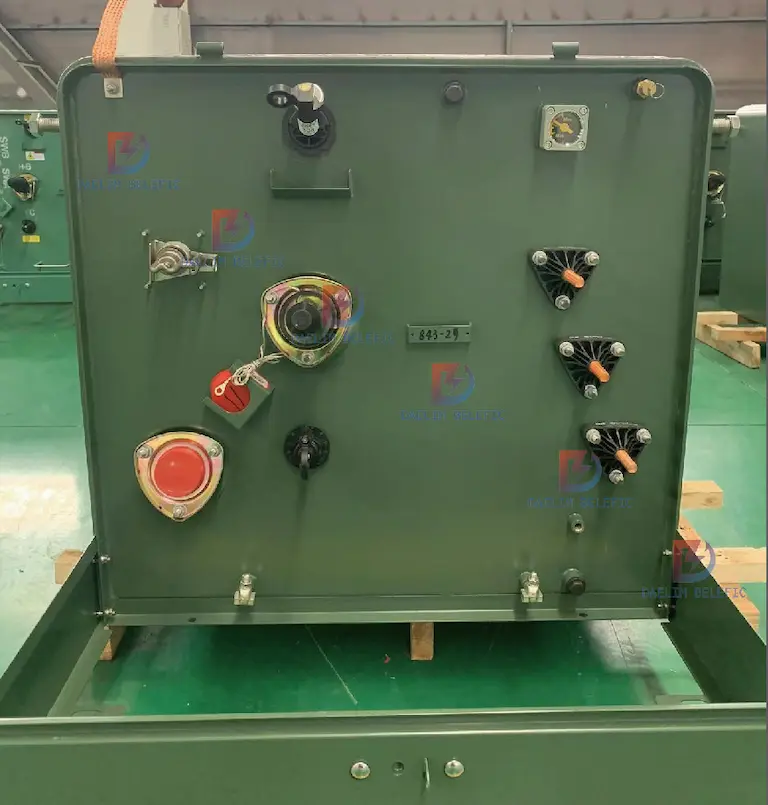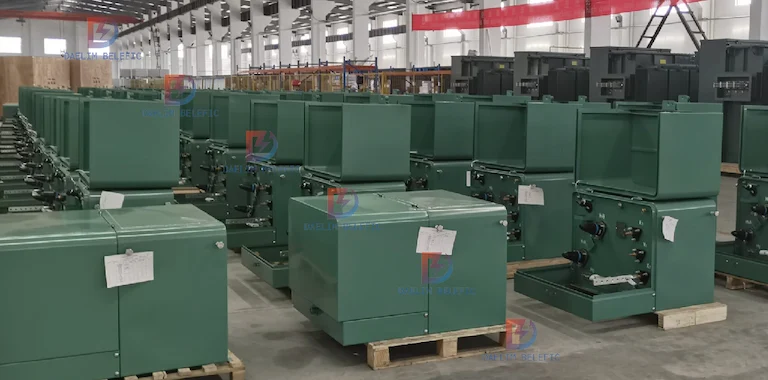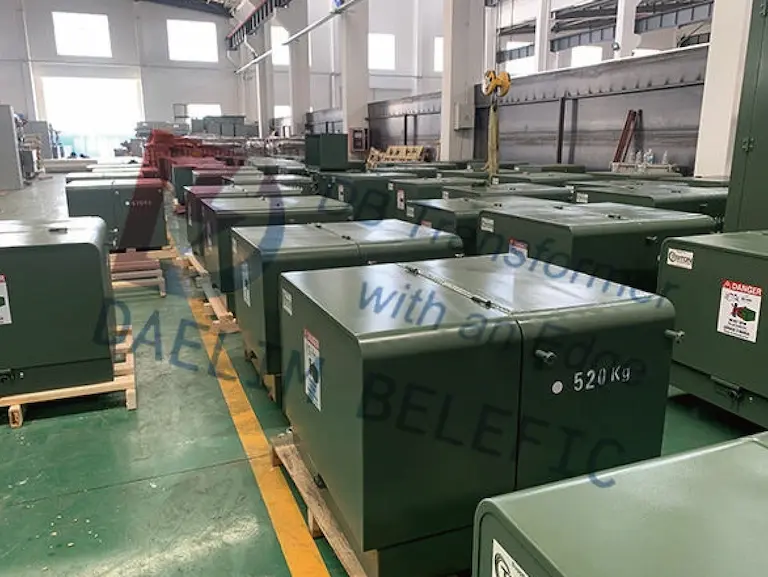ELECTRIC, WITH AN EDGE

A 50 kVA pad mounted transformer is an effective, safe, and space-saving remedy for converting electrical power to functional voltages in numerous setups. Its ground-level installment, safe enclosure, and customizability make it a favored selection for numerous urban and country applications.
Pofessional Manufacturer of Pad Mounted Transformer Substation Transformer,HV Power Transformer Single Phase Transformer IEEE/ANSI,CSA,DOE,AS/NZS,IEC and etc。standards

A pad-mounted transformer is an energy circulation transformer meant for ground degree. Confined a protected metal cupboard, it is normally placed on a concrete pad, which gives it its name. This sort of transformer is commonly made use of in domestic areas, industrial areas, and light industrial websites to transform high-voltage power to a reduced voltage that is appropriate for the particular area it powers.
Learn More about the: 1500 kva Pad mounted Transformer
Learn More about the: 1000 kva Pad mounted Transformer

Primary Side Wiring:
The key side of a 50 kVA pad mounted transformer normally handles greater voltage degrees.
Wiring here attaches the transformer to the major power grid.
This side might include adapters or bushings for high-voltage lines, usually varying from 11 kV to 35 kV, relying on regional criteria.
Secondary Side Wiring:
The second section takes care of the lower voltage outcome made for use Typical configurations consist of single-phase-phase arrangements, with voltage alternatives such as 120/240V or 277/480V. The connections in this area web link to distribution panels or are directly connected to consumer circuits.
Grounding:
Appropriate grounding is crucial for safety and security and performance.
The transformer’s storage tank and core ought to be linked to a grounding system to guarantee mistake currents have a safe path to the ground.
Tap Changer Connections (if applicable):
Specific transformers are outfitted with tap changers to readjust voltage degrees.
The setup of faucet changers calls for intricate wiring that is best delegated the experience of specialists.
Protection Devices:
It is essential to include fuses, circuit breakers, and rise defense into the electric system to secure the transformer from too much tons and power surges.
Qualified Personnel Only:
Qualified electrical specialists that understand the risks and safety treatments must be the only ones conducting wiring tasks.
De-energizing the Transformer:
Before starting any circuitry tasks, make certain that the transformer is completely separated from all power sources and completely de-energized.
Using Appropriate PPE:
It is essential to don ideal protective equipment, such as thermal handwear covers, protective eyeglasses, and flame-resistant clothing, to guarantee individual safety and security Personal Protective Equipment (PPE).
Adherence to Electrical Codes:
Wiring should comply with regional and nationwide electric codes to ensure security and legitimacy.
Verification of Voltage Ratings:
Make certain to validate the voltage rankings on both disparities that might cause hurt or threat.
Proper Grounding:
Guarantee a trusted grounding system to avoid electrical shocks and short circuits. Carry Out Lockout-Tagout Procedures:
Apply lockout-tagout procedures to guarantee that the transformer can not be unintentionally stimulated during circuitry.
Routine Maintenance:
To ensure the reputable functioning of transformers, it’s essential to execute routine checks and upkeep after they’ve been installed.
Sustainable Practices for a Better Future
Think about how environmental problems such as wetness and temperature level may influence electrical wiring elements and connections.
“Preventing Information Overload”
Validate that the transformer is not running beyond its maximum capacity of 50 kVA, as excessive loading can create the transformer to overheat and fail.
For thorough wiring layouts and specific electrical wiring techniques, it’s constantly suggested to consult the transformer’s maker manual or a specialist electrical engineer. Each transformer model may have special functions that need specific circuitry factors to consider
Learn More about the: pad mounted transformer
Brand and Manufacturer: Prices can vary significantly between different brands and makers based on their reputation, quality of elements, and solution offerings. Product Quality: Premium products, specifically in the core and windings, can raise the cost. Use copper versus light weight aluminum windings, for instance, influences both performance and expense. Modification and Features: Personalized features like unique voltage scores, faucet changers, or included security attributes can increase the price. Particular style modifications to fulfill particular sector standards or environmental conditions.
Energy Efficiency Ratings: Transformers with higher effectiveness ratings might set you back even more initially however can provide financial savings in the long-term via decreased power losses. Air Conditioning System Type: The type of cooling system (natural air, required air, oil-cooled) can influence the overall price.
Conformity with Standards: Conformity with different international and neighborhood requirements (like IEEE, IEC) can include in the cost because of the better and safety needs. Setup and Accessories: Added components such as bushings, rise arrestors, and protective relays, as well as setup and commissioning solutions, can include in the overall cost. Guarantee and After-sales Service: Extensive guarantees and extensive after-sales solution packages can increase the price however deal higher comfort. Market Conditions: Changes in resources prices, labor fees, and adjustments in economic conditions can affect the final cost.
Supplier Direct Sales: Acquiring straight from the manufacturer can ensure credibility and extensive support. Several suppliers offer custom-made options customized to certain demands. Electric Supply Companies: Specialized electric supply business typically have a range of transformers from numerous producers, supplying the opportunity to compare different designs and costs. Online Industrial Marketplaces: Platforms like Alibaba, ThomasNet, and Grainger can offer affordable prices and a broad choice of items from different suppliers. Neighborhood Distributors and Dealers: Acquiring from local suppliers may use benefits like reduced shipping prices, easier accessibility to after-sales service, and quicker installation. Made Use Of and Refurbished Equipment Sellers: For more economical options, think about reputable vendors of used or refurbished transformers, which can offer considerable cost savings. Sector Trade Shows and Expos: Going to exhibition can supply chances to see a range of items, negotiate prices, and develop direct contact with producers or distributors. Consulting with an Electrical Engineer or Contractor: For those much less aware of electric devices, seeking advice from an expert can assist in making a notified purchase that fits certain requirements. When acquiring a transformer, it's important to balance first expenses with long-term value, thinking about factors like efficiency, reliability, lifespan, and after-sales support. Obtaining several quotes and contrasting options based on overall price of ownership as opposed to just the initial purchase cost can result in far better decision-making.
Learn More about the: 300 kva pad mount transformer

The price of a 50 kVA pad mounted transformer can vary commonly based on numerous variables consisting of brand name, construction products, details functions, and local market conditions. Since my last update in April 2023, the price range for a 50 kVA pad mounted transformer can typically fall anywhere in between $5,000 to $15,000 USD.
However, this is a basic quote and the real price can be beyond this range depending on:
For the most precise and current rates, it’s advised to get in touch with manufacturers or distributors directly for quotes. They can provide comprehensive pricing based on your details needs and include any type of added expenses such as shipping, setup, and after-sales solutions.
Learn More about the: 2500 Kva Pad Mounted Transformer
Definition and Overview:
A 50 kVA pad mounted transformer is a vital part in electrical distribution systems, made for ground-level installation and usually framed in a safe, lockable metal cabinet.
Specifications and Features:
The system can deal with 50 kVA and is developed to fulfill details input and outcome voltage demands. It includes durable build top quality, effective cooling systems, safety measures, and compliance with sector regulations.
Wiring and Safety:
High voltage is regulated by the main side, whereas the second side deals with reduced, extra user-friendly voltage. Safety is of utmost value when it concerns wiring, with a strong focus on grounding, using personal protective devices, and following electric codes purely.
Factors Affecting Price
The price is influenced by aspects like supplier reputation, material top quality, power efficiency ratings, conformity with standards, and extra attributes or services included in the acquisition.
Acquisition Sources:
Pad placed transformers with a power rating of 50 kVA are readily available for purchase from different sources such as producers, electrical supply firms, online commercial marketplaces, regional distributors, and suppliers providing utilized and reconditioned tools.
Estimating Project Costs:
According to the most current info, the expense of the item can range $5,000 and $15,000 USD, relying on numerous aspects such as personalization, brand reputation, market problems, and others.
Manufacturer Websites and Catalogs:
Perfect for extensive product information, customized features, and getting in touch for rates and advice.
Electrical Engineering Textbooks and Guides:
Deal fundamental expertise on transformer design, feature, and safety and security factors to consider.
Online Courses and Webinars:
Systems like Coursera, Udemy, and industry-specific webinars supply thorough knowing chances on electrical systems and transformers.
Resources for Industry Insights
The Institute of Electrical and Electronics Engineers (IEEE) and International Electrotechnical Commission (IEC) disseminate industry-leading understanding and groundbreaking explorations via their magazines, including criteria and academic journals.
Events and Conventions:
Great for direct experience with various models, connecting with professionals, and attending interesting sessions.
Getting in touch with Others Online
Systems like Reddit’s engineering areas or expert LinkedIn groups use a chance to talk about with peers and experts.
Technical Blogs and Industry News Sites:
Remain updated with market fads, brand-new modern technologies, and sector news.
This recap gives a thorough understanding right into 50 kVA pad mounted transformers, reviewing their essential characteristics, elements to consider throughout installation, costs, and sources for acquisition. If individuals want to check out the topic more thoroughly, the provided resources supply a guide for extra research study and understanding purchase.
Regular Inspection and Testing:
Regular monthly: Visual examination for physical damages, oil leakages, or indications of meddling.
Annually: Comprehensive check consisting of insulation resistance screening, oil tasting for dielectric strength and dissolved gas evaluation (DGA), and thermographic examinations to detect hot spots.
Preventive Maintenance:
Every 3-5 Years: Thorough interior inspection, checking for damage, deterioration, or connection issues. Substitute of parts like gaskets and bushings as required.
As Required: Cleaning and painting the exterior to avoid rust.
Condition Monitoring:
Uninterrupted monitoring of temperature level, oil degree, and stress with fitted gauges and sensing units, when practical.
Fixing issues with a 50 KVA pad mounted transformer.
Common Issues and Solutions:
Keep in mind: Always adhere to safety procedures throughout troubleshooting, including de-energizing the transformer and making use of proper PPE.
The length of time does a 50 KVA pad-mounted transformer typically last?
Life Expectancy:
Generally, a pad mounted transformer with an ability of 50 kVA can have a life expectancy of around 20 to 30 years, which is affected by factors such as just how it is utilized, the maintenance routines adhered to, and the quality of its construction.
Aspects Influencing Lifespan:
Transformers situated in extreme conditions might experience a shortened life span.
Tons Management: Consistent overloading can shorten the life expectancy.
Maintenance: Regular, thorough maintenance can dramatically expand a transformer’s life-span.
Quality of Components: High-quality materials and construction methods contribute to a longer life-span.
End-of-Life Indicators:
When a transformer experiences repeated failures or requires substantial repair work, it might be approaching the end of its serviceable life. In these instances, it’s typically much more affordable to change the system entirely instead of continuing to buy maintenance and repair initiatives.
Learn More about the: 700 kva Pad mounted Transformer